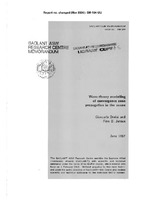| dc.contributor.author | Dreini, Giancarlo | |
| dc.contributor.author | Jensen, Finn B. | |
| dc.date.accessioned | 2018-10-11T14:05:51Z | |
| dc.date.available | 2018-10-11T14:05:51Z | |
| dc.date.issued | 1987/06 | |
| dc.identifier | 1672 | |
| dc.identifier.govdoc | SM-194 | |
| dc.identifier.uri | http://hdl.handle.net/20.500.12489/162 | |
| dc.description.abstract | Improved numerical techniques together with continual advances in computer technology have now | |
| dc.description.abstract | made it feasible to study sound propagation in the deep ocean with wave-theory models and hence | |
| dc.description.abstract | avoid the artefacts and approximations associated with standard ray-theory analysis techniques. We apply a computationally efficient normal-mode code to the problem of convergence zone propagation, | |
| dc.description.abstract | which is the repetitive focusing of sound (every 40-60 km) in the upper part of the ocean for an acoustic source near the sea surface. In the study we investigate the structure of the first 3 convergence zones as a function of geographical area (Mediterranean and Atlantic), season (summer and winter), frequency (25-200 Hz), and source/receiver depth (15-300 m). It is shown that convergence-zone propagation only occurs under summer conditions, and that the focusing of sound is much stronger in the Atlantic than in the Mediterranean. Moreover the convergence zone length is around 60 km in the Atlantic and just 35-40 km in the Mediterranean. | |
| dc.format | 22 p. : ill. ; 36 fig. | |
| dc.language | English | |
| dc.publisher | NATO. SACLANTCEN | |
| dc.relation.ispartofseries | ADA183607 | |
| dc.subject | Acoustic propagation | |
| dc.subject | Ocean acoustics | |
| dc.subject | Atlantic Ocean | |
| dc.subject | Mediterranean Sea | |
| dc.title | Wave theory modelling of convergence zone propagation in the ocean | |
| dc.type | Scientific Memorandum (SM) | |
